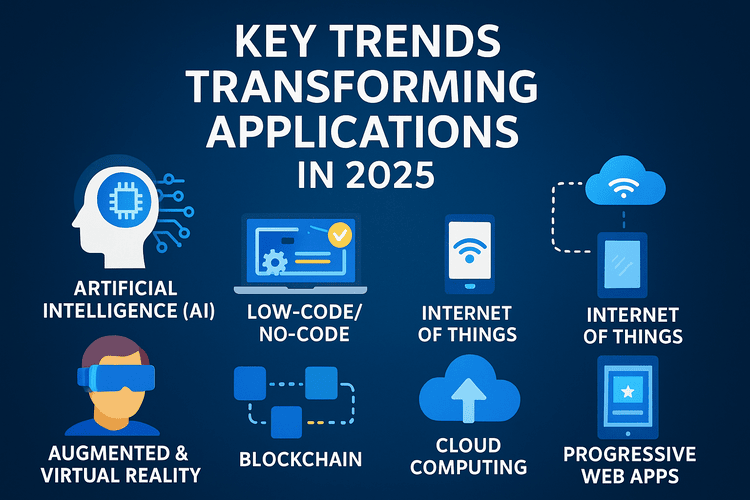Custom app development has completely transformed the way businesses operate. Recent studies reveal that nearly 87% of companies rely on custom applications to streamline processes, improve efficiency, and gain a competitive edge.
As technology continues to evolve rapidly in 2025, organizations across industries are recognizing the immense value of tailored applications—not only for operational optimization but also for enhancing customer experiences and driving revenue growth.
The demand for customized software solutions continues to rise, with the global custom app development market projected to reach $181.81 billion by 2031, according to The Insight Partners. Unlike generic apps, custom solutions focus on delivering future-ready, niche-specific capabilities.
To stay ahead in the competitive landscape, it’s crucial to be aware of the latest trends shaping the development of mobile and web applications. This article highlights the top custom app development trends in 2025 and explains why they matter for businesses.
What Is Custom App Development?
Custom app development refers to creating tailored mobile or web applications designed specifically to meet the unique needs of a business. Unlike off-the-shelf solutions, custom apps are built to align with specific workflows, goals, and processes, offering higher flexibility and control.
Key advantages of custom applications include:
- Providing solutions tailored to business and user needs.
- Supporting improved customer engagement with personalized experiences.
- Maintaining functionality and relevance as technology evolves.
With these benefits, businesses can streamline operations, enhance productivity, and offer a more seamless experience to users.
Why You Should Track Emerging Trends
Developing a custom application requires time and resources, but staying updated on emerging trends ensures that your app remains relevant, secure, and competitive. Here’s why businesses should monitor the latest developments:
- Strategic Investment Decisions: Knowledge of trends helps organizations make informed choices about technology adoption.
- Future-Proof Solutions: Integrating new trends early ensures that applications stay current and scalable.
- Competitive Advantage: Early adoption can provide an edge over competitors slow to innovate.
- Enhanced User Experience: Many trends focus on improving usability and engagement, crucial for user retention.
- Optimized Development: Trends often streamline the development process, reduce costs, and speed up time-to-market.
- Improved Security: Staying updated helps protect sensitive data and maintain trust in an increasingly digital environment.
Key Trends Transforming Applications in 2025
To stay competitive, businesses need to keep an eye on the latest trends in custom app creation. From Artificial Intelligence to Blockchain, these technologies are reshaping the way applications are built and used, impacting everything from user experience to operational efficiency. Here are the most influential trends driving change today:

1. Artificial Intelligence (AI)
AI continues to revolutionize industries, and app development is no exception. Applications powered by AI can enhance user experience, automate complex tasks, and streamline business processes. Machine learning and natural language processing are increasingly integrated into apps to deliver personalized experiences and smarter decision-making.
Key benefits include:
- Automation of repetitive or complex tasks
- Data-driven insights for improved decisions
- Tailored experiences for individual users
- 24/7 support via AI chatbots
- Enhanced operational efficiency and productivity
According to IDC forecasts, global AI spending is projected to reach $632 billion by 2028, reflecting its critical role in future-ready applications.
2. Low-Code and No-Code Platforms
Low-code and no-code tools are becoming mainstream, allowing both technical and non-technical users to build and maintain applications quickly. These platforms reduce development complexity, lower costs, and foster greater collaboration between IT teams and business units.
Benefits include:
- Faster app creation and deployment
- Improved agility in responding to business needs
- Reduced reliance on specialized developers
- Easier maintenance and updates
- Cost-effective development solutions
By empowering citizen developers alongside professionals, businesses can accelerate digital transformation without compromising flexibility or scalability.
3. Internet of Things (IoT) Integration
The rise of connected devices has made IoT a key trend in app development. Modern applications increasingly integrate with wearables, smart appliances, and sensors, enabling seamless communication between devices and systems.
Advantages include:
- Real-time data collection and actionable insights
- Enhanced operational efficiency
- Improved safety and security measures
- Better customer experiences via connected devices
- Predictive maintenance and smarter workflows
IoT-enabled applications allow businesses to harness data from multiple sources, streamlining operations and improving decision-making.
4. Augmented and Virtual Reality (AR & VR)
AR and VR technologies are creating immersive experiences across industries such as gaming, education, healthcare, and retail. By incorporating AR/VR into applications, businesses can provide interactive, personalized, and engaging experiences for users.
Key benefits:
- Immersive user interactions
- Enhanced training and educational tools
- Virtual prototyping and product visualization
- Advanced entertainment and gaming features
- Remote collaboration and assistance
The AR/VR market is projected to reach $210.4 billion by 2030, underlining its growing influence in app development.
5. Blockchain Technology
Blockchain offers secure, transparent, and tamper-proof solutions for managing data and transactions. Apps leveraging blockchain provide trustworthy digital records for payments, supply chains, and sensitive information.
Key benefits include:
- Increased data security and integrity
- Reduced fraud and operational errors
- Transparent supply chain management
- Cost reduction through streamlined processes
- Traceable and verifiable transactions
This technology is gaining traction as businesses look to ensure trust, efficiency, and future-proof solutions.
6. Cloud-Based Applications
Cloud computing remains a dominant trend in 2025, enabling businesses to manage apps, data, and resources on scalable platforms without relying solely on physical infrastructure.
Advantages include:
- Enhanced scalability and flexibility
- Cost-effective IT resource management
- Automatic updates and maintenance
- Stronger security measures
- Improved disaster recovery and accessibility
By leveraging cloud solutions, organizations can scale operations efficiently while maintaining high performance and security.
7. Progressive Web Apps (PWAs)
PWAs combine the best of mobile and web applications, delivering app-like experiences directly through web browsers without installation. They offer fast load times, offline functionality, and platform independence.
Why they matter:
- Seamless user experience across devices
- Quick access without app store downloads
- Offline usage and reliable performance
- Lower development and maintenance costs
PWAs are increasingly favored by businesses aiming to provide high-quality user experiences while keeping development streamlined.
Final Thoughts
Custom app development in 2025 is centered on innovation, efficiency, and user experience. By embracing trends such as AI, IoT, low-code platforms, and AR/VR, businesses can create applications that are not only functional but also future-ready.
Staying updated on these trends ensures that apps remain competitive, secure, and aligned with evolving market demands. With careful planning and implementation, a well-designed custom application can become a critical asset that drives growth and enhances customer engagement.

